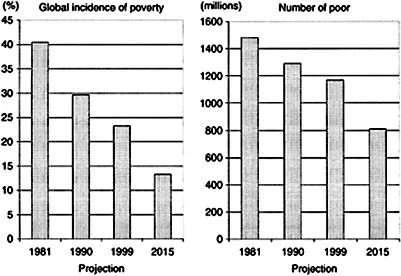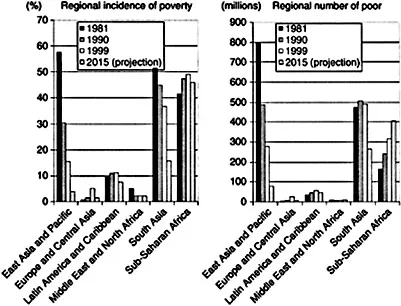
eBook - ePub
Macroeconomic Policies and Poverty
This is a test
- 400 pages
- English
- ePUB (mobile friendly)
- Available on iOS & Android
eBook - ePub
Macroeconomic Policies and Poverty
Book details
Book preview
Table of contents
Citations
About This Book
In this volume, world-renowned contributors, including Martin Ravallion, Michael Kremer and Robert Townsend, deal with the institutional characteristics of poverty resulting from the time pattern of aid, the nature of financial systems and the political economy of budgetary decisions. Going beyond the traditional literature on poverty, this original book deals with themes of broad interest to both scholars and policymakers in a clear yet technically sophisticated manner.
Departing from conventional methods employed in poverty studies, these innovative essays enquire into the institutional characteristics of poverty, and using current case studies, they examine the crucial idea that periods of crises seriously affect poverty.
Frequently asked questions
At the moment all of our mobile-responsive ePub books are available to download via the app. Most of our PDFs are also available to download and we're working on making the final remaining ones downloadable now. Learn more here.
Both plans give you full access to the library and all of Perlego’s features. The only differences are the price and subscription period: With the annual plan you’ll save around 30% compared to 12 months on the monthly plan.
We are an online textbook subscription service, where you can get access to an entire online library for less than the price of a single book per month. With over 1 million books across 1000+ topics, we’ve got you covered! Learn more here.
Look out for the read-aloud symbol on your next book to see if you can listen to it. The read-aloud tool reads text aloud for you, highlighting the text as it is being read. You can pause it, speed it up and slow it down. Learn more here.
Yes, you can access Macroeconomic Policies and Poverty by Ashoka Mody, Catherine Pattillo, Ashoka Mody, Catherine Pattillo in PDF and/or ePUB format, as well as other popular books in Business & Business General. We have over one million books available in our catalogue for you to explore.
Part I
Issues in macroeconomics
and poverty
Can public policies lower poverty?
An overview
Ashoka Mody and Catherine Pattillo*
The global incidence of extreme poverty—the percentage of the world population with incomes less than $1 a day—and the absolute numbers of poor people have been falling since 1981. The first target of the Millennium Development Goals—to halve, between 1990 and 2015, the proportion of people in extreme poverty—is likely to be met at the global level (World Bank, 2004). The data underlying these trends remain controversial. Bhalla (2002) argues that the extent of global poverty reduction has been greater than these figures indicate, while Deaton (2002) has emphasized inconsistencies in reported poverty trends.
Although the global incidence of poverty is declining, progress has been uneven across countries (Figure 0.1) and some of the most challenging problems lie ahead. At one extreme, East Asian economies have been extremely successful in tackling poverty as past decades have produced spectacular growth that has increased opportunities for fruitful employment. Projections suggest a continuation of these trends. In contrast, in Sub-Saharan Africa, the incidence of poverty and, especially, the number of poor people has been rising. In 2015, nearly half the African population is expected to have incomes below the poverty line. South Asian trends have been favorable to poverty reduction, but the size of the numbers in poverty will remain large for several years (Figure 0.2).
At an April 2001 workshop, Stanley Fischer, then the Fund's First Deputy Managing Director, highlighted why the International Monetary Fund (IMF) needed to extend its analytical capabilities beyond its traditional focus on macro-economic stabilization to include an assessment of the effects of IMF-supported programs on the incidence of poverty. The IMF, he noted, lends to many countries where poverty is an overriding problem, and its policy advice (e.g. on fiscal spending, taxation, and inflation) affects poor people in special ways. Moreover, policies will not be politically sustainable unless they lead to equitable outcomes. And beyond such pragmatism, he argued, lies a moral obligation for the IMF to address the sources and consequences of poverty.1
The chapters in this book take seriously Fischer's challenge and consider how economic policies, crises, and income distribution interact with each other and with economic growth to deliver poverty outcomes. Recognizing the generally accepted proposition that economic growth is crucial for poverty reduction, this book nevertheless emphasizes the importance of particular country circumstances in mediating the relationship between growth and poverty reduction and hence presents several country studies focusing on policy measures for, and the political economy of, poverty alleviation. This line of research is of relatively recent origin, reflecting a view that specific country circumstances matter in the determination of poverty outcomes. As such, many of the essays use micro data and innovative techniques to analyze how fiscal policies, structural policies such as financial reforms and trade liberalization, and large shocks and policy responses affect inequality and poverty.

Figure 0.1 Global poverty ($1 a day poverty line).
Sources:
http://www.developmentgoals.org/Poverty.htm#percapita for 1990,1999, and 2015 values.
http://www.worldbank.org/research/povmonitor/ for 1981
values.

Figure 0.2 Regional poverty ($1 a day poverty line).
Sources:
http://www.developmentgoals.org/Poverty.htm#percapita for 1990, 1999, and 2015 values and
http://www.worldbank.org/research/povmonitor/ for 1981
values.
Many of the chapters in the book were first presented at an IMF conference in March 2002 and have been subsequently revised and updated. We have been fortunate also in adding other ongoing research to this collection. Three overarching policy lessons emerge from this analysis. First, fiscal policies are potentially valuable for reducing poverty but are subject to important political economy forces that limit their usefulness. Second, structural policies, relating, for example, to financial sector and trade liberalization, not only unleash long-term growth but also are likely to increase inequalities, implying somewhat reduced effectiveness in lowering poverty. Third, crises that originate in natural disasters are particularly harmful to the poor in low-income countries; in contrast, recovery from financial crises in middle-income countries is easier and hence the impact on the poor is less severe.
The current consensus and the open questions
In principle, poverty reduction occurs through two channels: first, growth raises average incomes and, hence, reduces poverty; second, poverty is reduced even more when the rise in incomes especially benefits the poor. Reflecting a widely held consensus, Kraay (2003) finds that in the medium-to-long run, much of the variation in poverty trends can be attributed to growth in country average incomes. However, he finds that changes in income distribution are also empirically important in determining poverty reduction.
The perspective that growth in average incomes is the most important channel for poverty reduction is supported by two of this book's chapters in Part I. These chapters suggest, as do other studies based on cross-country growth regressions, that country policies do not impact poverty trends over and above their effect through growth.2 Sahay et al. (Chapter 1) ask whether, given the rate of per capita GDP growth, economic policies account for improvements in the human development index, which is highly correlated with poverty. They document the stylized fact that none of the policy or institutional variables considered has a significant and robust association that has either pro-poor or anti-poor implications. Berg and Krueger (Chapter 3) find persuasive the evidence that trade openness is an important determinant of growth. However, they conclude that trade openness does not have systematic effects on poverty beyond its effect on growth.
Ravallion (2004) stresses, however, that focusing on average effects based on crosscountry regressions masks the wide variation across countries in the impact of a given growth rate on poverty. Averages across countries, he argues (p. 15), “can be quite uninformative about how best to achieve pro-poor growth in specific countries.” Going beyond the cross-country averages, the initial level of inequality and changes in inequality over time are the main proximate causes of the differing rates of poverty reduction at given rates of growth.3 Ravallion finds, for example, that poverty responds only slowly to growth in high inequality countries.4
To inform policy, it therefore becomes important to understand the dimensions of inequality that matter, including, for example, access to both private (human and physical) capital and public goods. However, Kraay (2003) finds that cross-country evidence is particularly uninformative in pointing to the determinants of changes in income distribution. Thus, while cross-country evidence provides some guidance on measures that spur growth, the policy analyst faces a greater challenge in proposing measures to influence distribution. Kraay (2003) is led to suggest the need for more micro-level and case study research. Similarly, Ravallion (2004) calls for more country-level studies on the underlying determinants of changes in inequality and the specific factors influencing the growth elasticity of poverty.
The chapters in this book address this common call from different perspectives for country-level studies of the determinants of changes in inequality. However, to set the stage and provide a link to the cross-country literature, Part I has three chapters: a summary of the literature on macroeconomic policies and poverty; a survey on the important topic of trade and poverty; and an overview of state-of-the-art methodologies for analyzing public policies, shocks, and poverty. The chapters in Parts II and III, then, analyze the poverty implications of fiscal policy (changes in the progressivity of taxation or large spending cuts) as well as structural policies such as financial liberalization and trade reform. Part IV focuses on the impact of large shocks or crises on both income distribution and average consumption growth that underlies poverty measures. The rest of this overview chapter clarifies the channels through which fiscal and structural policies influence poverty, highlights briefly the international policy dimensions raised in two of the chapters, and concludes by suggesting the policy directions that emerge from the chapters in this book.
Public policies: channels of impact on poverty
What are the channels through which public policies and shocks affect income distribution and poverty? Fiscal policy—changes in the tax structure; changes in spending, transfers, or subsidies; increases in prices of publicly provided services; or reductions in public sector employment or real wages—can have both direct and indirect effect on income distribution (Agénor, 2002). Spending changes, for example, could reduce the consumption of the poor or their purchasing power, but the ultimate effect depends on the extent to which social expenditure disproportionately benefits poor or rich households. The indirect effects of fiscal policy operating through changes in aggregate demand are not clear-cut: mechanisms operate both to reduce aggregate demand and, hence, worsen poverty in the short run, though long-run effects may be more beneficial if, for example, inflationary pressures are contained.
As financial liberalization, growth, and inequality evolve over time, the implications for poverty reduction are complex. Financial liberalization may benefit the poor by allowing greater access to credit and improving risk sharing. Improved access to credit could allow poor households to better smooth consumption in bad times, invest in riskier but more productive technologies, and invest more in education. However, financial liberalization could worsen inequality. The ability to earn higher interest rates on savings tends to benefit the wealthy most. And the availability of credit to finance investment could assist potential low-wealth entrepreneurs who are not from the poorest strata of society. In such a setting, growth accompanying financial liberalization may have limited poverty reduction effects.
The links between trade liberalization and income distribution and poverty are similarly complex. Trade liberalization lowers import prices for poor consumers and producers, and increases export prices for po...
Table of contents
- Cover
- Macroeconomic Policies and Poverty Reduction
- Routledge Studies in the Modern World Economy
- Full Title
- Copyright
- Contents
- List of figures
- List of boxes
- List of tables
- List of contributors
- PART I Issues in macroeconomics and poverty
- PART II Public finances
- PART III Finance and trade
- PART IV Crises and shocks
- Index